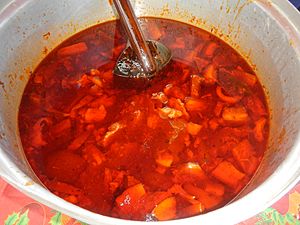Philippine asado facts for kids

Pork asado from Pampanga
|
|
| Course | Main course |
|---|---|
| Place of origin | Philippines |
| Associated national cuisine | Filipino cuisine |
| Serving temperature | Hot |
| Variations | Asado de carajay; pork asado |
| Similar dishes | Humba, pata tim, adobo, hamonado |
Philippine asado refers to two different kinds of Filipino meat dishes. The word asado comes from Spanish and means "grilled." This name was first used for a Chinese-Filipino barbecue dish.
However, the Filipino versions of asado are actually braised (cooked slowly in liquid), not grilled. One type is called pork asado, which is often sweet. The other is asado de carajay, which has a savory (not sweet) taste.
Different Kinds of Asado
Asado de Carajay
Asado de carajay is a traditional Filipino asado. The name comes from the word carajay, which means "wok" in Philippine Spanish. In Filipino languages, it's called kawali or kalaha.
This dish is made with meat like pork, beef, or chicken. It's cooked slowly in soy sauce, bay leaves, peppercorns, calamansi (a small citrus fruit), and onions. It also includes vegetables such as tomatoes, potatoes, mushrooms, and carrots. It's usually cooked in a wok, which is a round-bottomed cooking pan.
Asado de carajay is different from the "Chinese-style" pork asado. It uses vegetables, doesn't have Chinese spices, and tastes savory. Also, you can make it with beef or chicken, not just pork.
Pork Asado
Pork asado is also known as "Chinese" asado. It's the most common type of asado people think of. This dish comes from the Chinese dish char siu, and maybe also from a Chinese dish called tau yew bak.
Unlike char siu, which is grilled, pork asado is always braised. It's made with pork cooked slowly in soy sauce, garlic, bay leaves, onion, brown sugar, and Chinese spices. These spices often include star anise and five spice.
Pork asado is very similar to other Filipino dishes like humba and pata tim. These dishes also came from Chinese-Filipino immigrants. It also tastes a bit like hamonado because it's sweet, but hamonado uses pineapples and is a native Filipino dish.
Pork asado is usually sliced thin and served with its cooking liquid. It's also often shredded and used as a filling for sandwiches and buns. It's the main filling for the Filipino steamed bun called siopao, which is sometimes called siopao asado.
There's a special kind called "Macau-style" pork asado. It uses the same ingredients. But the meat is boiled directly in the marinade until it's tender, instead of being cooked beforehand.


